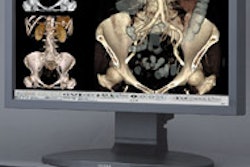CHICAGO - Medical device developer Fujifilm Medical Systems of Stamford, CT, has come to this year's RSNA conference with a quiver of new products and enhancements, as well as an expanded vision for its Synapse PACS product line.
PACS
Fuji is debuting version 3.1 of Synapse, which includes enhancements to the firm's Reading Protocol technology, said Bob Cooke, executive director of marketing, network systems. Reading Protocols will now include series renaming as well as clinical conferencing capabilities, which allow users to save a precise study view and then recall that view later.
The company has also enhanced its SWAT (Synapse Web Administration Tools), allowing administrators to analyze various aspects of departmental workflow. Administrators will also be able to automatically "push" installation of Synapse to users, easing deployment, according to the firm.
Synapse 3.1 will include CT image processing capability, being shown by Fuji as a work-in-progress. Fuji has taken its computed radiography image processing tools and applied it to CT studies. The resulting capabilities may obviate the need for separate bone and lung windowed studies, said Clayton Larsen, vice president of marketing and network development.
With Synapse 3.1, multisite facilities can use Synapse to access images on other PACS networks. Other additions include expanded integration options for dictation systems. Synapse version 3.1 is scheduled for release in the first quarter of 2005.
Fuji executives are also discussing a new, expanded vision for Synapse, which will evolve into what the company is calling a "knowledge management" system. With this approach, called Comprehension, Synapse will be expanded to manage the entire radiology clinical and business processes, allowing users to begin to retire their legacy RIS applications, Cooke said.
Elements of Comprehension are being shown as a work-in-progress, including a task-oriented workflow that allows users to navigate their work processes without having to perform complex queries, according to the firm.
Fuji is also emphasizing a new partnership with Silicon Graphics, which will add the Mountain View, CA-based vendor's Prism visualization platform to Synapse. With Prism, Fuji aims to bring advanced visualization into the routine diagnostic process, with no differentiation between the visualization application and the imaging application, Cooke said.
With its "volume exploration" concept, Fuji believes that there should be no trade-offs in interactive system performance and image quality, regardless of where it's being interpreted. In addition, all exams should be able to benefit from the technology, Cooke said. The company also believes an industry standard platform should be used to develop the visualization architecture.
Prism utilizes a shared-memory architecture, which provides speeds data computing and graphics generation, Fuji said. The firm also believes its AON compression approach will pay dividends with 3D visualization tasks, allowing for the native use of already-compressed isotropic voxel-based data sets.
In other announcements, the vendor is also debuting its Synapse multimodality breast imaging workstation configuration in the U.S. The workstation is designed for any facility performing full-field digital mammography (FFDM) and other modalities such as breast MR or ultrasound, according to Fuji.
The workstation incorporates dual, 5-megapixel flat-panel monitors for soft-copy diagnosis with an optional third, 20-inch (51-cm) color LCD monitor for productivity applications and viewing of color images. Image presets, window/level, pan, zoom, annotation, and magnification, as well as the firm's proprietary Reading Protocol technology are available on the workstation.
In addition to its FFDM capabilities, the workstation configuration can be used as a full-featured diagnostic workstation for any imaging exam, according to Fuji.
X-ray
The FCR Pocket ID is a portable personal digital assistant-type device that interfaces with the vendor's Flex UI digital x-ray software application, according to Penny Maier, national marketing manager for digital x-ray. The Pocket ID boasts a form factor approximately the size of a television remote control and allows technologists to access patient worklists and identify exposed imaging plates in CR cassettes.
The device transmits patient data through a USB connection, and permits a technologist to carry a workstation worklist when performing portable x-ray studies. A built-in barcode reader in the Pocket ID allows a technologist to scan patient barcodes to associate with a study, reducing the possibility for medical error, Maier said.
Fuji is also showcasing its FCR for scoliosis, a combination of interlocking CR cassettes and image-stitching algorithms that permits full back imaging, according to Maier. The system is comprised of two cassettes providing 14 x 34-inch (35.6 x 86.4-cm) coverage, or three cassettes that will provide a 14 x 50-inch (35.6 x 127-cm) image. The plates overlap and contain internal markers that provide set points for the auto stitching application to merge the images, she said.
Fuji is also demonstrating a new image-processing algorithm, multifrequency processing or MFP, for digital x-ray. MFP combines both density and edge-enhancement capabilities in a single tool. The processing application is available now to current Fuji customers as an upgrade, and will be a standard offering on new installs later this year, Maier said.
The firm is also highlighting its temporal subtraction image-processing tool. The application automatically subtracts the differences between current and past comparative Fuji CR chest images, according to the developer.
Temporal subtraction uses a warping algorithm to eliminate the effect of differences in patient positioning while comparing changes in anatomy. For easier distinction of the present and past images, the date is automatically indicated at the top of each image displayed.
The company is displaying its FCR Velocity-T (for table exams) and Velocity-U (for chest and other upright exams) featuring its HD LineScan technology, which can provide a throughput of up to 240 images per hour with a fully processed image available in less than nine seconds, the company said.
Maier said that the Velocity products are most commonly purchased as a SpeedSuite installation, although they can also be added to existing x-ray generating equipment. A seamless, integrated digital room replacement, SpeedSuite coordinates all technique selection, as well as tube, collimator, and detector motion, Maier said. A full room replacement can be obtained for less than $500,000.
Imagers
Fuji has added DryPix 4000 to its family of DryPix hardcopy imagers. The dry laser imager is suitable for decentralized printing applications and is directed at the midrange market, said Robert Neary, national marketing manager, imaging systems.
Fuji is pointing to the unit's compact size and 110-volt power supply, as well as its 50-micron pixel resolution and 3.60 maximum density capability. It can print up to 110 14 x 17-inch films an hour, and up to 160 smaller-sized films per hour, according to the vendor.
In addition, the imager utilizes Fuji's Image Intelligence image-processing software, and prints to the edge of the film for true-size images without cropping, Neary said. DryPix 4000 includes a built-in DICOM print server, and is compatible with an optional DryPix station for automatic fail-over benefits.
Other options include a four-bin film sorter and a mobile kit that provides shock protection, Neary said. DryPix 4000 will have a list price of approximately $50,000, with availability expected in the second quarter of 2005.
By Jonathan S.
Batchelor and Erik L. Ridley
AuntMinnie.com staff writers
November 30, 2004
Copyright © 2004 AuntMinnie.com



















